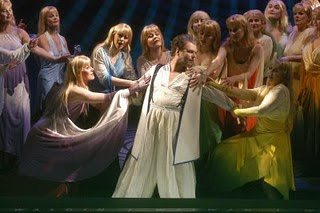Parsifal – Stefan Vinke
Gurnemanz – James Moellenhoff
Klingsor – Jürgen Kurth
Kundry – Lioba Braun
Amfortas – Tuomas Pursio
Titurel – Roman Astakhov
First Knight of the Grail – Tommasso Randazzo
Second Knight of the Grial – Roman Astakhov
Esquires – Soula Parassidis, Jean Broekhuizen, Timothy Fallon, Norman Reinhardt
Alto solo – Claudia Huckle
Flowermaidens – Elena Tokar, Diana Schnürpel, Kathrin Göring, Soula Parassidis, Ines Reintzsch, Claudia Huckle
Roland Aeschlimann (director, designs)
Susanne Raschig (costumes)
Lucinda Childs (movement)
Ilka Weiss (assistance with designs and movement)
Lukas Kaltenbäck (lighting)
Chorus and Supplementary Chorus of the Leipzig Opera (chorus master: Volkmar Ulbrich)
Children’s Choir of the Leipzig Opera (Sophie Bauer)
Leipzig Gewandhaus Orchestra
Ulf Schirmer (conductor)
 |
| Images: Andreas Birkigt Stefan Vinke (Parsifal) with the Flowermaidens |
Parsifal on Good Friday, in the city of Wagner’s birth: how could one resist? I had enjoyed Roland Aeschlimann’s 2006 production, a Leipzig co-production with Geneva and Nice, when seeing it two years previously, and for the most part did so again, though there were perhaps some passages, especially during the third act, when its status as a repertory piece was now a little too evident. A little sharpening up of the stage direction would do no harm. This remains, however, an interesting and attractive production, which continues to remind me of Herbert Wernicke’s woefully underrated – at least by critics – Tristan for Covent Garden (not least when one recalls the reductionist Christof Loy staging that has succeeded it). Abstraction is not only the way to proceed in Wagner: the greatest current stage interpreter of his works, Stefan Herheim, is anything but abstract. Nevertheless, abstraction works well – especially when contrasted with the irrelevant pseudo-psychology that infects a good number of current Wagner productions.
Colour, as I wrote last time around, plays an important role, both in demarcating locations and in the dramatic transformations – an especially important concept in this of all Wagner’s dramas – that occur within particular scenes. That is the aspect which perhaps above all puts me in mind of the aforementioned Wernicke Tristan. I remain intrigued and equally uncertain about Aeschlimann’s Grail. Amfortas uncovers something mysterious – no problem there – and holds up a sheet which, by a trick of lighting presents what continues to remind me of a Turin Shroud-vision of Christ. I still wonder whether, even at this stage, we need something a little more substantial – in more than one sense – to offer sustenance for Monsalvat’s community Yet, by the same token, something else, again mysterious, is revealed, which clearly replenishes the community. The open-endedness of what is going on is very much in Wagner’s spirit of intellectual exploration and continual self-questioning. Visual centrality of the spear remains very much to the benefit of the second act, though I cannot help but regret the usual awkwardness at the end, when Parsifal refers to a sign (of the Cross) that he does not make. It need not be that particular Christian sign, of course, though it may be, but to have nothing at all simply does not seem to work very well.
 |
| End of Act II: Petra Lang is pictured here; on the present occasion, she was replaced by Lioba Braun |
Musically there was much to admire. The Leipzig Gewandhaus Orchestra sounded very much in its element, rich and dark of tone, especially in the strings. There were, especially during the first act, a few too many fluffs, not least during the Prelude, but once things had settled down, this ceased to be a problem. Much the same could be said of Ulf Schirmer’s direction. He may not come across as a great Wagnerian, but he is a dependably good one. Line is generally maintained, though parts of the third act dragged a little (not, I should stress, a matter of speed, but of dramatic momentum), though the Prelude to that act was world-weary indeed. Much of the cast was the same as I heard two years ago. Stefan Vinke’s Parsifal has gained a certain edge, or at least it had on the present occasion: there is still much to appreciate, but I hope the loss of freshness was temporary. James Moellenhoff’s Gurnemanz and Tuomas Pursio remain distinguished, though I sensed a certain lack of stage direction when contrasted with 2009. The major difference in the cast was Susan Maclean’s replacement by Lioba Braun, whom I had heard before as Kundry in Dresden, also in 2009. Then she was excellent, and so she was on this occasion, ever-attentive to the alchemic marriage of words and music, and notably more seductive – a matter of the production as much as anything else? – during the second act. Praise ought also to be offered to the excellent chorus, supplementary chorus, and children’s choir. Wagner’s interest in earlier music, not least as reflected in his early Das Liebesmahl der Apostel and his arrangement of Palestrina’s Stabat Mater, was evoked and translated into modern terms. Clarity and weight worked in tandem, to sometimes overwhelming effect.